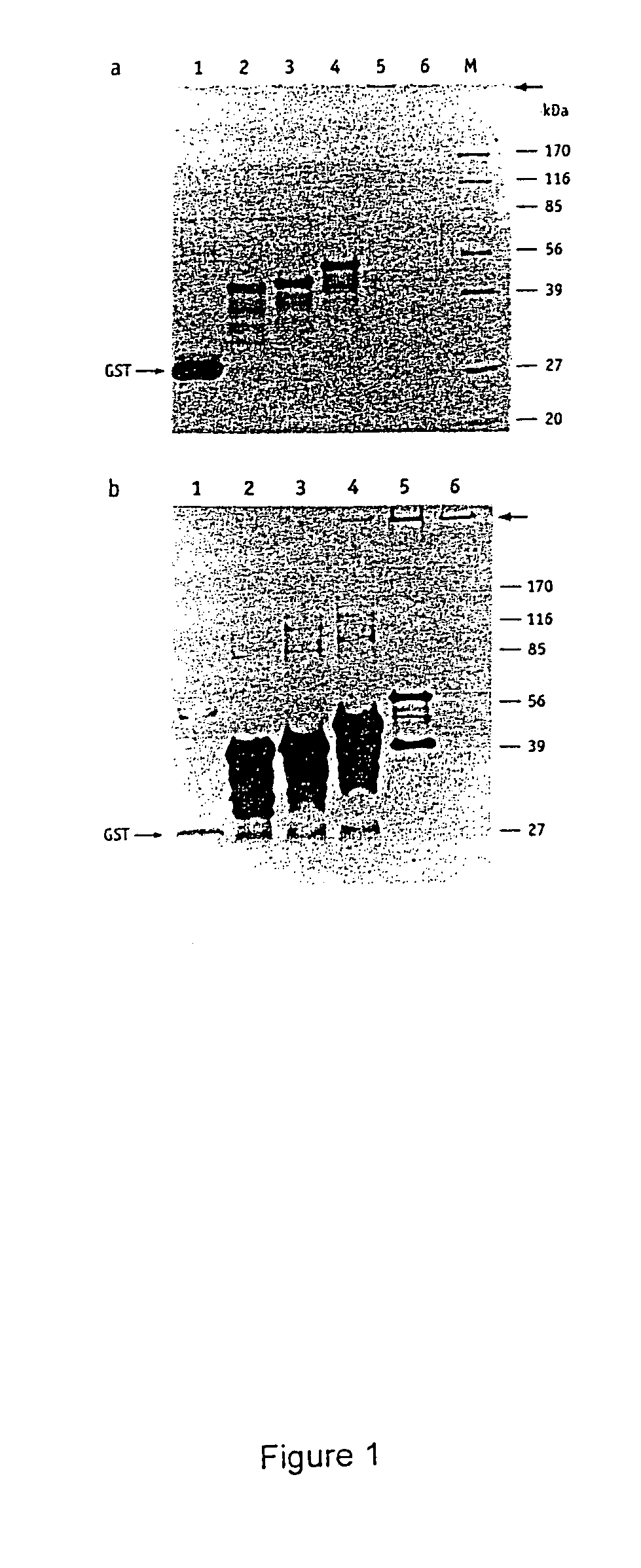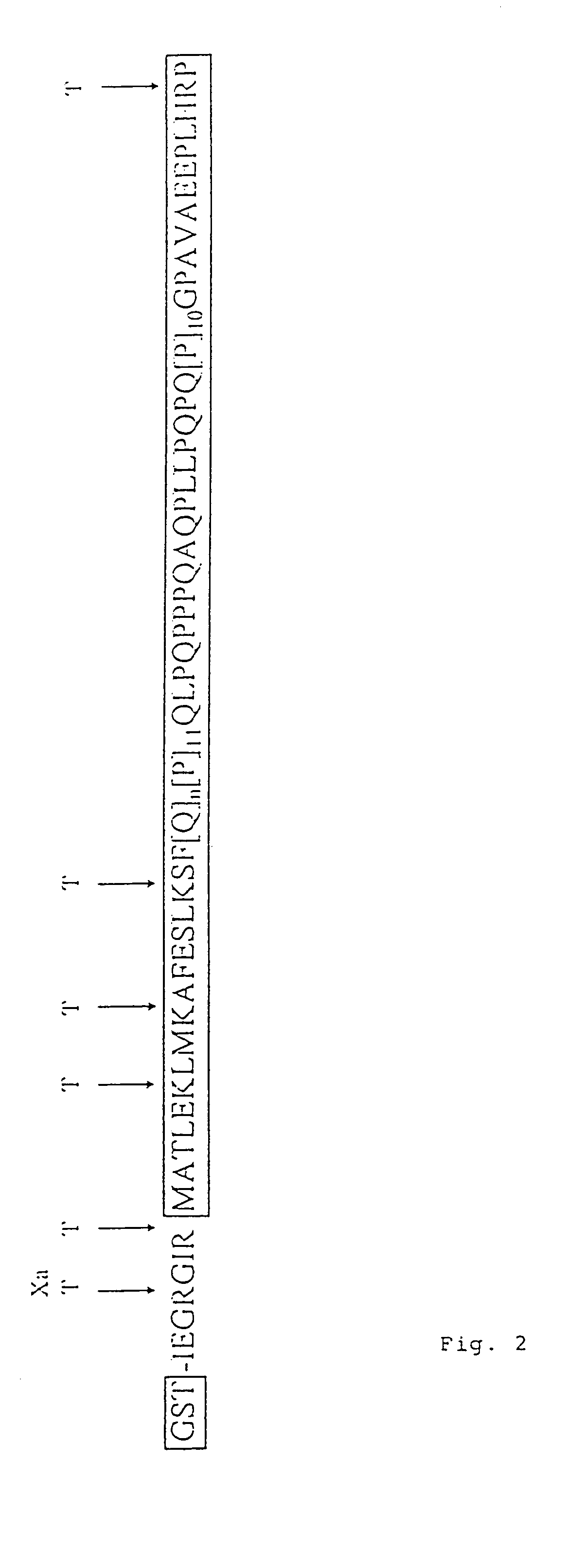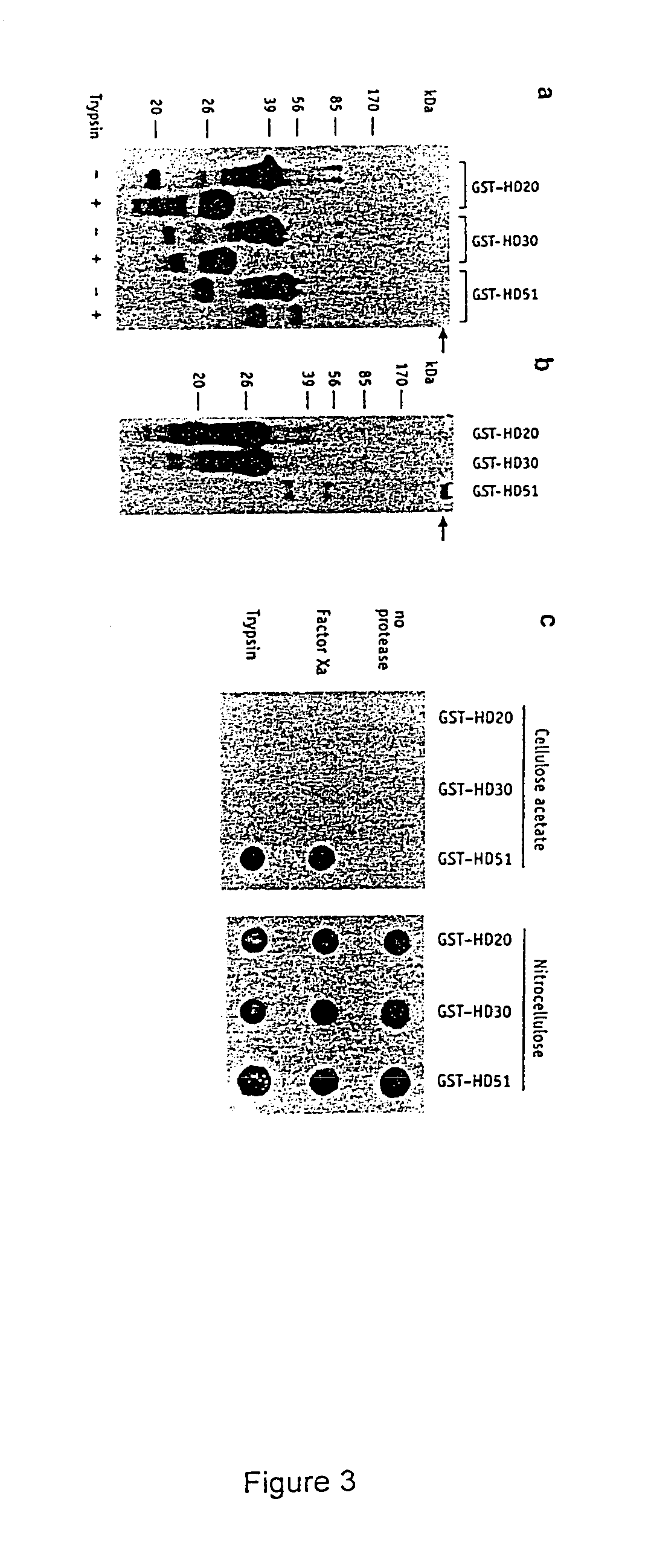Composition and method for the detection of diseases associated with amyloid-like fibril or protein aggregate formation
a technology of amyloid-like fibrils and aggregates, which is applied in the direction of immunoglobulins against animals/humans, biological material analysis, peptides, etc., can solve the problems of not being able to demonstrate whether the binding of these proteins to huntingtin is involved, observed selective neuronal loss, and gain of function, etc., to achieve short time, convenient, direct, easy to test in vitro
- Summary
- Abstract
- Description
- Claims
- Application Information
AI Technical Summary
Benefits of technology
Problems solved by technology
Method used
Image
Examples
example 2
Proteolytic Cleavage of GST-HD Fusion Proteins Containing Expanded Polyglns
[0112]It has been shown previously that the solubility of certain proteins can be enhanced by the addition of the GST-tag (Smith and Johnson, 1988) and it was therefore of interest to determine whether the removal of the GST-tag by proteolytic cleavage would have an effect on the solubility of the polygln-containing fusion proteins. Potential factor Xa and trypsin cleavage sites within the GST-HD fusion proteins are shown in FIG. 2. Factor Xa cleaves between the GST-tag and the HD exon 1 protein whereas trypsin removes an additional 15 amino acids from the N-terminus and a single proline from the C-terminus, both proteases leaving the polygln repeat intact. The GST-HD20, -HD30 and -HD51 proteins were digested with trypsin under conditions designed to remove the GST-tag from the fusion protein without it being totally degraded. After cleavage, proteins were denatured by boiling in the presence of 2% SDS and an...
example 3
Huntingtin Proteins Containing Expanded Polyglns in the Pathological Range Aggregate to Amyloid-Like Birefringent Fibrils
[0114]Electron microscopy of negatively stained GST-HD51 fractions showed oligomeric particles with diameters of 6 to 7 nm (FIG. 4a); no higher ordered aggregates were observed. For electron microscopic observation, the native or protease-digested GST-HD fusion proteins were adjusted to a final concentration of 50 μg / ml in 40 mM Tris-HCl (pH 8.0), 150 mM NaCl, 0.1 mM EDTA and 5% glycerol. Samples were negatively stained with 1% uranyl acetate and viewed in a Philips CM100 EM. In contrast, protein fractions obtained by proteolytic cleavage of GST-HD51 showed numerous clusters of high molecular weight fibrils and ribbon-like structures (FIGS. 4b, c, d and e), reminiscent of purified amyloids (Prusiner et al., 1983). The fibrils obtained after digestion with factor Xa showed a diameter of 10–12 nm and their length varied from 100 nm up to several micrometers (FIGS. 4...
example 4
Huntingtin Proteins Containing Expanded Polyglns Form Amyloid-Like Protein Aggregates In Vivo
[0116]To determine whether the amyloid-like protein aggregates formed by proteolytic cleavage of GST-HD51 in vitro are also present in vivo, nuclear protein fractions of brain and kidney were prepared from mice transgenic for the HD mutation (line R6 / 2) and littermate controls (Davies et al., 1997; Mangiarini et al., 1996). Nuclei from the brain or kidney of an R6 / 2 hemizygous mouse with a repeat expansion of (CAG)143 (Mangiarini et al., 1996) at ten weeks of age and littermate control were prepared as follows. Whole brain samples (80 mg) in 400 ml of 0.25 M sucrose in buffer A (50 mM triethanolamine [pH 7.5], 25 mM KCl, 5 mM MgCl2, 0.5 mM DTT, 0.5 mM PMSF) were homogenized using 15 strokes of a tight-fitting glass homogenizer. The homogenate was adjusted to a final concentration of 5 mM DTT, and centrifuged at 800 g for 15 min. The supernatant was recentrifuged at 100,000 g for 1 h, and the...
PUM
| Property | Measurement | Unit |
|---|---|---|
| length | aaaaa | aaaaa |
| temperature | aaaaa | aaaaa |
| body weight | aaaaa | aaaaa |
Abstract
Description
Claims
Application Information
 Login to View More
Login to View More - R&D
- Intellectual Property
- Life Sciences
- Materials
- Tech Scout
- Unparalleled Data Quality
- Higher Quality Content
- 60% Fewer Hallucinations
Browse by: Latest US Patents, China's latest patents, Technical Efficacy Thesaurus, Application Domain, Technology Topic, Popular Technical Reports.
© 2025 PatSnap. All rights reserved.Legal|Privacy policy|Modern Slavery Act Transparency Statement|Sitemap|About US| Contact US: help@patsnap.com



